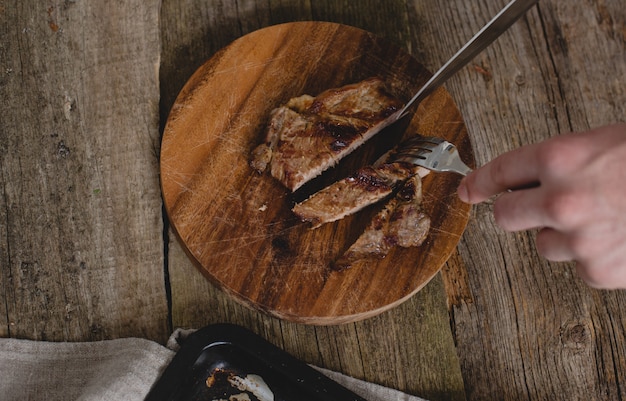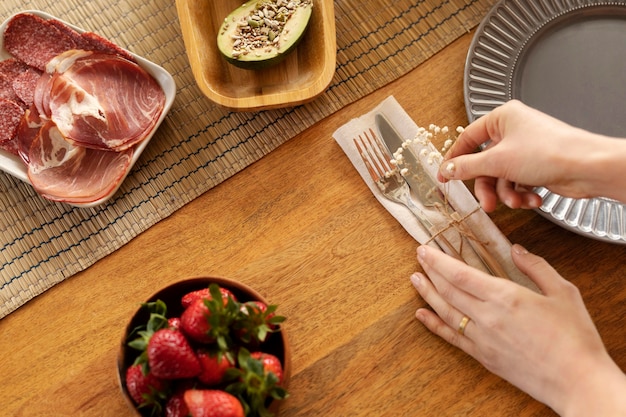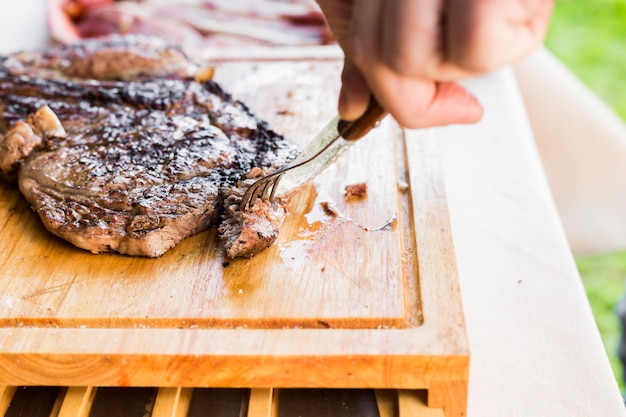Ah, steak. The very word conjures images of sizzling, smoky perfection, a symphony of flavour and texture that melts in your mouth. As a seasoned chef, I've dedicated countless hours to mastering the art of the perfect steak, experimenting with different cuts, techniques, and seasonings. Along the way, I've learned a few tricks, uncovered some hidden secrets, and even had my fair share of steak-related mishaps. But that's all part of the journey, right? Today, I'm going to share my ultimate guide to cooking a perfectly juicy thick steak – a guide that's not just about achieving that coveted golden sear, but also about understanding the science behind it all. So grab a fork, a knife, and a glass of something refreshing, and let's embark on this delicious journey together.
(Part 1) choosing the right cut – The Foundation of Flavor

Remember the saying, "You can't make a silk purse out of a sow's ear?" The same applies to cooking steak. The choice of cut is paramount. You wouldn't use a tough, lean cut for a pan-seared steak, just like you wouldn't use a delicate filet mignon for a hearty steak sandwich. Here's a breakdown of some of my favorite cuts and what makes them special:
1. The Rib-Eye: The King of Marbling
Let's face it, the rib-eye is a steak legend for a reason. Its marbling, those delicate veins of fat interspersed throughout the muscle, is what makes it melt-in-your-mouth delicious. This marbling adds richness, tenderness, and an unparalleled flavour. A good rib-eye is like a culinary symphony, a balance of fat and lean that creates a truly unforgettable dining experience.
2. The new york strip: Lean and Delicate
For those who prefer a more delicate texture and a slightly leaner flavor, the New York strip is a fantastic choice. It's a classic for a reason, and it's always a crowd-pleaser. The New York strip has a beautifully even grain that allows for even cooking and a wonderfully tender texture. The flavor is rich but not overpowering, making it a versatile choice for various dishes.
3. The Filet Mignon: The Pinnacle of Tenderness
For those who crave the ultimate in tenderness, the filet mignon reigns supreme. It's cut from the smaller, more delicate part of the tenderloin, resulting in a steak that melts on your tongue. Now, it's a bit on the pricier side, but the melt-in-your-mouth texture and delicate flavour are worth every penny. Filet mignon is best enjoyed simply seasoned and cooked to a perfect medium-rare, allowing its natural flavour to shine.
4. The skirt steak: The budget-friendly Hero
Don't underestimate the humble skirt steak! It's a surprisingly flavorful and versatile cut, and it's much more affordable than the fancy options. The skirt steak is long and thin, with a coarser grain than other cuts. It boasts a bold, beefy flavour and a slightly chewy texture. The key to cooking skirt steak is to cook it quickly over high heat, preventing it from becoming tough. It's perfect for grilling, stir-frying, or making delicious steak tacos.
(Part 2) Preparing Your Steak – Setting the Stage for Success

Now that you've chosen your perfect cut, it's time to prepare it for its grand entrance. These simple steps will ensure your steak is ready to shine.
1. Pat it Dry – The Importance of a Dry Surface
The first rule of steak? Dry it off! A damp steak will steam instead of sear, resulting in a less-than-ideal crust. Pat it dry with paper towels and let it sit at room temperature for about 30 minutes. This allows the steak to come to room temperature, ensuring more even cooking.
2. Seasoning: The Art of Simple Perfection
Less is more when it comes to seasoning. Salt and pepper are your best friends here. Season liberally about 30 minutes before cooking, giving the salt time to work its magic and draw out moisture, which will create a more flavorful steak. Salt, as it draws out moisture, also helps to develop a more flavorful crust.
3. Don't Be Afraid of a Little Oil
A light coating of oil helps create a beautiful, crispy crust. Just a drizzle will do the trick. I prefer to use a high-heat oil like avocado or grapeseed oil, as these have a higher smoke point and won't burn before the steak gets a nice sear.
(Part 3) Choosing the Right Cooking Method – Finding Your Steak Style

With your steak prepped and seasoned, it's time to choose your cooking method. Each method offers a unique flavour profile and texture, allowing you to tailor your steak experience to your preferences.
1. The Classic Pan-Seared Steak – Simplicity at its Finest
This is my go-to method for a quick and easy meal. Get a cast iron skillet screaming hot, add a little oil, and sear the steak for about 2 minutes per side for a medium-rare finish. The key here is to achieve a beautiful, crispy crust while maintaining a tender, juicy interior. The pan-searing method allows for a concentrated flavour and a crispy exterior.
2. The Grill Master – The Sizzle and Smoke of Perfection
There's nothing quite like a perfectly grilled steak. Preheat your grill to medium-high heat, and cook the steak for about 4 minutes per side for medium-rare. The grill imparts a smoky flavour and those beautiful grill marks, making it a classic choice for outdoor dining. If you're grilling, make sure your grill grates are clean and well-oiled to prevent sticking.
3. The Oven-Roasted Method – Hands-Off, Flavorful Results
For a more hands-off approach, try oven-roasting your steak. Preheat your oven to 400°F (200°C), and roast the steak for about 10-12 minutes per side for medium-rare. This method provides a more even cook throughout the steak, making it ideal for thicker cuts. You can also add aromatics like onions, garlic, or herbs to the oven for additional flavour.
(Part 4) Mastering the internal temperature – Finding Your Perfect Doneness
No matter your cooking method, knowing the internal temperature is crucial for achieving the perfect level of doneness. It's the key to unlocking that perfect balance of tenderness, juiciness, and flavor.
1. Don't Rely on Your Eyes – The Importance of a meat thermometer
You can't always tell how cooked your steak is just by looking at it. A steak may appear brown and crispy on the outside, but the inside might be raw or overcooked. Use a meat thermometer to ensure it's cooked to your liking.
2. The Doneness Chart – A Guide to steak perfection
Here's a quick guide to internal temperatures and doneness:
| Doneness | Internal Temperature (°F) |
|---|---|
| Rare | 125-130°F |
| Medium-Rare | 130-135°F |
| Medium | 140-145°F |
| Medium-Well | 150-155°F |
| Well-Done | 160°F or higher |
Remember, these are just guidelines. Personal preference is key!
(Part 5) The Art of Resting – Letting the Steak Relax and Redistribute Flavor
Don't underestimate the importance of resting your steak! Resting allows the juices to redistribute, resulting in a more tender and flavorful steak. Think of it as a brief moment of calm for your steak to settle down and recover from the heat. After cooking, transfer your steak to a cutting board and cover it loosely with aluminum foil. Let it rest for at least 10 minutes before slicing and serving. This allows the juices to reabsorb into the steak, creating a more succulent and flavourful bite.
(Part 6) Serving Your Steak Like a Pro – Presentation Matters
Alright, your steak is cooked to perfection, and it's had its rest. Now it's time to serve it up like a culinary masterpiece!
1. The Perfect Cut – Slicing Against the Grain for Tenderness
Slice your steak against the grain to create tender and juicy bites. The grain refers to the direction of the muscle fibers. Slicing against the grain breaks those fibers, making it easier to chew and ensuring a more tender texture.
2. Sides That Shine – Complimenting the Steak with Flavour
Complement your steak with flavorful sides like roasted vegetables, creamy mashed potatoes, or a crisp salad. The sides should complement the steak, creating a well-balanced and satisfying meal. For example, a simple green salad can cut through the richness of the steak, while roasted vegetables can add depth and complexity to the flavour profile.
3. The Sauce Touch – Elevating the Steak with a Culinary Kiss
A simple sauce can elevate your steak to another level. Try a classic béarnaise, a rich and creamy peppercorn sauce, or a vibrant chimichurri. The sauce should enhance the flavour of the steak, not overpower it. A simple drizzle of sauce is often all that's needed to add a touch of elegance and depth to your steak.
(Part 7) Steak cooking tips and Tricks – Going Beyond the Basics
Now that you've got the basics down, let's dive into some handy tips and tricks to take your steak game to the next level. These are the secrets that seasoned chefs use to consistently deliver delicious results.
1. Invest in a Good Cast Iron Skillet – A Culinary Investment for Life
A cast iron skillet is a chef's best friend, especially for cooking steak. It heats up evenly and retains heat well, creating a beautiful sear. It's also durable and versatile, making it a valuable addition to any kitchen. A good cast iron skillet can last a lifetime with proper care, getting better with age.
2. Don't Crowd the Pan – Giving Your Steaks Space to Breathe
Give your steaks some breathing room in the pan. Crowding them will lower the temperature and lead to uneven cooking. This is especially important for pan-searing, as you want to create a beautiful, crispy crust without overcooking the steak.
3. Flip Only Once – Creating a Perfect Crust
Resist the urge to flip your steak multiple times. This will disrupt the sear and prevent a beautiful crust from forming. You want to allow the steak to cook undisturbed for a few minutes on each side to develop a crispy, flavorful crust.
4. Use a Meat Thermometer – The Key to Accurate Doneness
As I mentioned before, don't rely on your eyes to determine doneness. Use a meat thermometer to get an accurate reading. This ensures that your steak is cooked to your exact specifications, preventing overcooking or undercooking.
5. Rest, Rest, Rest – The Importance of Patience
I can't stress enough the importance of resting your steak. It makes a world of difference in terms of tenderness and flavour. It's a key step that many overlook, but it's crucial for unlocking the full potential of your steak.
(Part 8) FAQs – Addressing Your Burning Steak Questions
Let's address some common questions you might have about cooking steak. These are the queries that often come up in the kitchen, and I'm here to provide the answers you need.
1. What if my steak is too thick?
For thicker steaks, consider searing them in a pan first, then finishing them in the oven. This ensures even cooking and a beautiful crust. This method allows you to achieve a crispy exterior while ensuring that the interior is cooked to perfection.
2. How can I make my steak more flavorful?
Experiment with different marinades or rubs. Try a simple marinade of olive oil, garlic, and herbs, or a flavorful rub made with paprika, cumin, and chili powder. Marinades add moisture and flavour to the steak, while rubs create a delicious crust.
3. What if my steak is overcooked?
Don't fret! An overcooked steak isn't the end of the world. You can still salvage it by slicing it thinly and using it in a stir-fry or a salad. The overcooked steak can also be used in dishes like stews or soups, where the texture is less important.
4. What's the best way to store steak?
Store your steak in the refrigerator, wrapped tightly in plastic wrap or aluminum foil. You can also freeze it for up to 3 months. When freezing, wrap the steak tightly to prevent freezer burn, which can dry out the meat and affect its flavor.
5. What's the best way to clean my cast iron skillet?
Wash your cast iron skillet with hot water and a little soap. Avoid using abrasive scrubbers, as these can damage the seasoning. Dry the skillet thoroughly and rub it with a thin layer of oil. This helps to maintain the seasoning and prevent rust.
There you have it! My ultimate guide to cooking a perfectly juicy thick steak. I hope you enjoyed it, and I hope you find it useful. Now go forth and conquer the steak world, my friends. Happy cooking!
Everyone is watching

How to Cook Frozen Lobster Tails Perfectly: A Step-by-Step Guide
RecipesLobster. Just the word conjures up images of lavish meals, special occasions, and a taste of luxury. But let's...

Pigs in a Blanket Cooking Time: How Long to Bake for Perfect Results
RecipesAh, pigs in a blanket. Just the name conjures up images of those delightful little parcels of crispy pastry en...

Pork Fillet Cooking Time: How Long to Cook It Perfectly
RecipesPork fillet, or tenderloin as it's sometimes called, is a real favourite in our house. It's so versatile, and...

The Ultimate Guide to Tender, Juicy Pulled Pork
RecipesRight, let's talk pulled pork. It's one of those dishes that just screams "comfort food," doesn't it? I mean...

The Ultimate Guide to Cooking Sweet Potatoes: From Roasting to Mashing
RecipesSweet potatoes. Just the name conjures up images of warm, comforting dishes, bursts of vibrant color, and a to...
